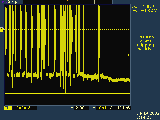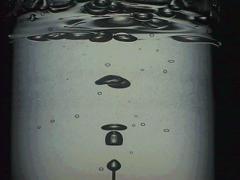Antibubble Breakthroughs
Electric Antibubbles?
 Some people might think that antibubbles are pretty boring -- that once
the initial novelty has worn off there's nothing much more to say about
them. I mean, they are just a bunch of soapy water, how exciting is
that?
Some people might think that antibubbles are pretty boring -- that once
the initial novelty has worn off there's nothing much more to say about
them. I mean, they are just a bunch of soapy water, how exciting is
that? As I said, some people might think that, but not Terry who has discovered Electrical Properties of Antibubbles. Using one part innovative setup and two parts clever imagination, Terry has discovered some amazing new properties of antibubbles. Have you ever tried to make antibubbles, but absolutely couldn't; then you tried a few minutes later and were making them without problem? Terry discovered that the electric potential difference between the inner and outer fluid is critical. If it's too large, antibubbles can't form. To control this potential, Terry delevloped an advanced antibubble making apparatus. Electric behaviour, as well as many other curiosities about a-bubbles are now explained by Terry's ground breaking work. Be sure to check out his site.
Chaotic Antibubbles?
 Alberto Tufaile from Sco Paulo Brazil is a scientist at Sco Paulo
University studying the chaotic dynamics of bubble formation. Along
with J. C. Sartorelli he recently published a paper Bubble and
Spherical Air Shell Formation Dynamics in Physical Review E,
November 2002, section Chaos and Pattern Formation. The main theme of
this paper is the antibubble formation.
Alberto Tufaile from Sco Paulo Brazil is a scientist at Sco Paulo
University studying the chaotic dynamics of bubble formation. Along
with J. C. Sartorelli he recently published a paper Bubble and
Spherical Air Shell Formation Dynamics in Physical Review E,
November 2002, section Chaos and Pattern Formation. The main theme of
this paper is the antibubble formation. He studied the formation dynamics of air bubbles emitted from a nozzle submerged in aqueous glycerol solutions of different viscosities. He described the evolution of the bubbling regimes by using the air flow rate as a control parameter and the time between successive bubbles as a dynamical variable. Some results concerning to bubbling coalescence were emulated with the combination of simple maps. He also observed the formation of air shells surrounding liquid drops inside the liquid, also known as antibubbles. The antibubbling conditions were related to an intermittent chaotic regime.
Formation Dynamics
S Dorbolo, H Caps and N Vandewalle in their paper have used a high speed camera to film fluid instabilities which take place when an antibubble forms and dies.If you use this page as inspiration for a science project or other great things, please send me a photo and/or a description of your results. I will post them here with credit to you. You'll be famous!
